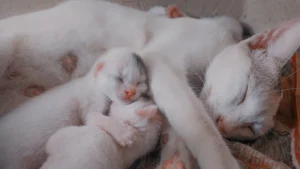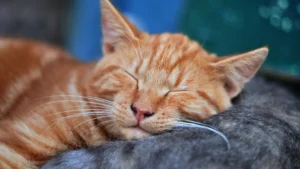Why Do Cats Sleep So Much: Cats are known for being masters of sleep. Curled on your lap, across your keyboard, nestled in a sunbeam, cats can and will sleep just about anywhere. But why exactly do our feline friends spend over half their lives asleep? Let’s delve into the science behind cats’ extraordinary sleeping habits.
Exploring the Reasons Behind Cat Naps
Delve into the various factors that influence cats’ sleep habits, from environmental cues and lifestyle factors to age, health, and breed differences. Gain insights into why cats prioritize sleep and how their sleeping patterns may vary based on individual needs and circumstances.
The Evolutionary Advantage of Catnaps
In the wild, cats are predators. Successfully hunting quick and agile prey like rodents, birds, and insects requires bursts of intense energy – running, leaping, and wrestling. To prepare their bodies and minds for these physically demanding hunts, cats needed to find a way to conserve their energy in between meals when no hunting was taking place.
The solution wild cats evolved? Frequent short catnaps. Unlike humans, who tend to sleep very deeply for relatively few continuous hours, cats sleep lightly in short increments, easily awakening to any noises or movement. These short 15-30-minute catnaps allow wild felines to fully rest their bodies while remaining alert and ready to react quickly to potential environmental dangers.
Even today’s fully domesticated house cats retain this natural evolutionary instinct to nap frequently to adapt to conserving energy. So, while your pet cat is not roaming the streets hunting mice and rabbits, that urge to take regular catnaps remains programmed deep within its DNA.
Hours of Shut-Eye
How much do cats sleep on average if you were to add up all those numerous quick catnaps? The amount varies based on life stage:
Kittens lead the way, sleeping an incredible 18-20 hours daily as they rapidly grow and develop. All that high-energy playtime you see for brief bursts is carefully balanced with lots of sleep to support their growing bones, muscles, and brains.
Adolescent cats become more active and have slightly lower sleep needs, around 16 hours daily. However, they make up for less sleep with somewhat erratic sleep-wake cycles. One minute, they’re sound asleep; the next, they’re wildly zooming around the house! These teenage cats exemplify what some refer to lightheartedly as ‘erratic energy.’
Adult cats beyond one-year-old settle into more predictable and consistent sleep/wake routines, averaging 15 hours of total sleep per day. An individual adult cat’s nap schedule often coincides with the household’s daily human routines since these bond with their families. Cats are entirely in tune with human meal times and activity patterns within their home environment.
Senior cats over ten tend to sleep even longer than younger adult cats – over 20 hours a day or more! Advancing age and joint diseases like arthritis make moving about difficult for older cats, so they adapt by conserving their energy reserves and strength by sleeping.
Light Sleep vs Deep REM Sleep
Not all cat sleep is equal in terms of depth or intensity. Veterinary sleep researchers have identified two main types of sleep that cats experience: relatively light sleep and deeper REM (Rapid Eye Movement) sleep.
Light sleep makes up about 3/4 of a cat’s overall slumber time. Lasting 15-30 minutes at a stretch, these short catnaps let kitty lightly rest while allowing her to react quickly to noises and movements in her vicinity. You’ll often notice your cat sleeping in this mode with its eyes only partly closed and ears occasionally flicking. Though not fully awake, they remain attuned to their surroundings.
Deep REM sleep offers the brain and body a chance to recharge after a long day fully. This phase comes in short 5-minute bursts interspersed between the extended periods of light snoozing. In this state, a cat is genuinely out cold. Some vivid feline dreams occur during deep REM sleep! You may witness them twitching or making little noises while their eyes rapidly move beneath their eyelids as their minds race with dreamscapes.
This alternating cycle between longer light dozing and shorter deep dreaming sleep syncs beautifully with cats’ natural hunting and foraging behaviors. The two types complement each other to keep cats optimally restored both physically and mentally.
Too Much or Too Little Sleep
While cats spend upwards of half their day engaged in some form of sleep, whether light or profound, dramatic changes in daily sleep patterns can signal health issues. Understanding your cat’s typical sleep/wake routine is key to recognizing more ominous abnormalities.
Increased sleep accompanied by low energy or loss of appetite can result from illness, infection, stress, or pain. Arthritis and dental disease are common causes of excessive sleep in senior cats especially.
Decreased sleep and agitation or erratic behavior may indicate hyperthyroidism, anxiety disorder, or cognitive decline. Insufficient daily stimulation and boredom can also lead to restless sleep, followed by acting out. In kittens and adolescents primarily, boredom fuels erratic snoozing.
If you notice your cat’s sleep schedule growing consistently off normal, contact your veterinarian promptly. They can give the kitty a thorough physical exam and check for any underlying physical or mental causes for the disrupted sleep. Providing a consistently enriching home environment for your cat and sticking to a regular daily feeding schedule, playtime, and human interaction can help minimize restless, disturbed sleep patterns.
The Nocturnal Origins of House Cats
While thoroughly adapted to domestic family life, we can’t forget that all modern house cats originally evolved from small, fierce, nocturnal wildcats native to the Middle East and Africa. Their ancient cousins were supreme nighttime hunters and foragers who thrived under the cover of darkness. The natural biological clocks and circadian rhythms that govern our pet cats’ sleep/wake cycles today are still preset to be most active after dusk.
Though remarkably flexible in adapting to modern human homes and daylight routines, many house cats retain remnants of their early ancestral patterns. Ordinary night owl behaviors like energetic zooming and pouncing after dark, staring out windows on the nocturnal wildlife patrol, or sneak attacks on unsuspecting wiggling toes underneath the bedcovers remain ingrained in house cat DNA.
So the next time you’re startled awake from a sound slumber by the pitter-patter of little cat feet or a cricket dropping ominously onto your pillow after an intense night hunt, just know it’s simply kitty expressing its natural hardwired programming! If those nocturnal urges aren’t excessive, view your cat’s after-dark adventures as amusing artifacts from the species’ past. Just be sure to give your cat plenty of appropriate outlets and spaces for nighttime play and exploration so you can achieve some peace after the sun sets.
Why Cats Can’t Resist Those Sunny Cat Naps
In addition to being famously nocturnal, what do most cats have in common with solar panels or sun-loving reptiles? They operate at peak performance capacity when given ample exposure to bright sunlight!
If you share your home with cats, you’ve likely witnessed them happily curl up and sleep for hours soaked in pools of golden afternoon sunlight. This heat-seeking snoozing behavior hearkens to cats’ ancient origins in the blazing bright deserts of the Middle East and Northern Africa. Though thoroughly adapted to domestic life, their genetic fondness for basking in heat and light remains deeply ingrained even generations after cats first ventured into our modern human homes.
Veterinarians report that our furry feline companions raise their core body temperature slightly by regularly napping and stretching out in sunny indoor spots. This boost supports improved digestion after meals, streamlined metabolism, and even enhanced immune function – not unlike cold-blooded lizards lifting their bodies to the sun! For arthritic senior cats significantly, a gentle warming from Old Sol can ease stiff joints.
Given kitties’ inherited love for solar snoozes, consider placing comfy cat beds and resting perches along sun-drenched floors or near sunny windows. Adjust these heat traps seasonally as the sun’s daily path shifts. You might also indulge your sunshine worshiper by investing in a safe, thermostatically controlled heated cat bed for their napping pleasure during colder months or dark rainy days.
Just be equally sure to provide your cat access to shadier, more excellent rest areas around your home so they can adequately thermoregulate and cool down when needed. Offering poolside lounging spots and cabana shade allows cats ample flexibility to freely drift between warming solar siestas and chillaxing respites.
With vantage points to sunny and shaded zones, your furry basket will enjoy the cat’s meow nap locations!
FAQs About Why Do Cats Sleep So Much
Do cats sleep more as they age?
Yes, older cats tend to sleep more than younger cats, as age-related changes in metabolism and activity levels affect their sleep patterns. Senior cats may spend up to 18 hours or more asleep per day to conserve energy and support their aging bodies.
Is it normal for cats to sleep during the day?
Yes, cats are crepuscular animals, meaning they are most active during dawn and dusk. It’s normal for cats to sleep during the day, especially if they’ve been active during the night or early morning hours. Providing a quiet, comfortable environment for daytime rest can help cats maintain healthy sleep habits.
Can cats suffer from sleep disorders?
Yes, cats can experience sleep disorders similar to humans, including insomnia, sleep apnea, and narcolepsy. These disorders may be caused by underlying medical conditions, environmental factors, or stressors. If you suspect your cat is experiencing sleep disturbances, consult with your veterinarian for proper evaluation and treatment.
How can I create a conducive sleep environment for my cat?
To promote healthy sleep habits in cats, provide a quiet, comfortable sleeping area away from noise and disturbances. Ensure your cat has access to a cozy bed or resting spot, and maintain a consistent sleep routine to help regulate their internal clock. Minimize disruptions during sleep and provide opportunities for mental and physical stimulation during waking hours to support overall well-being.
Why do cats sleep so much after eating?
After eating, cats may experience a period of drowsiness due to the digestion process. The body redirects energy resources to aid in digestion, leading to feelings of sleepiness or lethargy. This post-meal drowsiness is a natural response and typically resolves once the digestion process is complete.
Should I be concerned if my cat’s sleep patterns suddenly change?
Yes, sudden changes in a cat’s sleep patterns could indicate underlying health issues or stressors that require attention. Monitor your cat’s behavior closely and consult with your veterinarian if you notice significant deviations from their usual sleep habits, such as excessive sleepiness, restlessness, or difficulty sleeping.
Conclusion
In conclusion, cats’ penchant for sleep is deeply ingrained in their biology and behavior, serving essential functions for their health and well-being. By understanding the reasons behind why cats sleep so much and how to support their sleep needs, we can ensure that our feline companions lead happy, healthy lives filled with restful slumber.
Useful Equipment
Let us know down below if you found this article helpful. Do you think we left anything out?
If you are a cat or pet lover in general here are a few more articles you may find interesting:
- HOW TO KNOW IF YOUR CAT IS SICK
- FINDING THE PERFECT NAME FOR YOUR CAT
- WHY DO CATS HATE WATER SO MUCH? THE COMPLETE GUIDE FOR CAT OWNERS
- HOW TO TRAIN A KITTEN TO USE A LITTERBOX
- UNDERSTANDING AND DECODING YOUR CAT’S BODY LANGUAGE
- HOMEMADE DOG TREAT RECIPES FOR EVERY OCCASION




